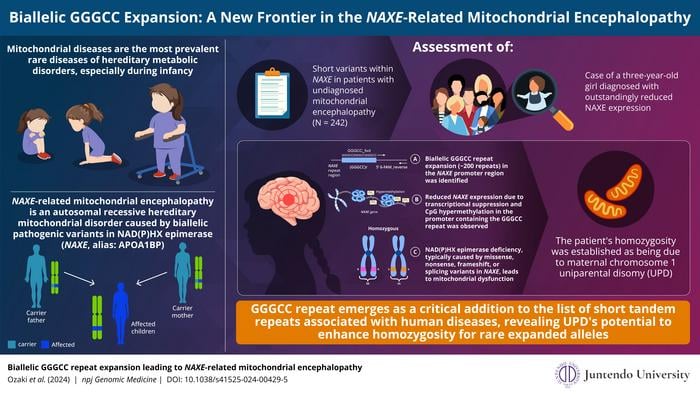In a new study, scientists have identified a novel genetic mutation linked to a rare mitochondrial encephalopathy. This discovery provides new insights into the genetic causes of mitochondrial diseases, which affect numerous vital cellular processes.
Published in npj Genomic Medicine | Estimated reading time: 6 minutes
Mitochondrial diseases are among the most common hereditary metabolic disorders, with one in every 5,000 births affected. They often result in severe neurological symptoms, including developmental delays and seizures. Recent research has uncovered a new cause of mitochondrial encephalopathy, a condition affecting the central nervous system (CNS), due to a genetic variation in the NAXE gene.
Led by Professor Yasushi Okazaki at Juntendo University, the team identified a biallelic GGGCC repeat expansion in the NAXE gene promoter region. This expansion, found in a three-year-old girl, significantly reduced the expression of the NAXE gene, which is responsible for producing an enzyme critical to mitochondrial function. This reduction in gene expression is linked to mitochondrial dysfunction and the development of severe CNS symptoms in the patient.
Professor Okazaki explains: “We were able to identify this rare genetic mutation through advanced sequencing technologies, including RNA sequencing and long-read sequencing. The repeat expansion led to a suppression of gene transcription, which was further exacerbated by hypermethylation of the repeat regions.”
Interestingly, the genetic analysis revealed that the patient inherited both copies of the mutated gene from her mother, a phenomenon known as uniparental disomy (UPD), where both copies of a chromosome come from one parent instead of one from each parent. This genetic anomaly likely contributed to the homozygosity of the repeat expansion.
Despite the challenging nature of identifying repeat expansions, especially those resistant to traditional sequencing methods, the study highlights the crucial role of long-read sequencing in uncovering these rare genetic disorders. The researchers emphasize that further investigation into the pathogenicity of similar repeat expansions is needed, with implications for future diagnostics and potential treatments for mitochondrial diseases.
Glossary
- Repeat Expansion: A genetic mutation where a segment of DNA is repeated multiple times, which can disrupt normal gene function.
- Mitochondrial Encephalopathy: A disorder caused by mitochondrial dysfunction, leading to neurological symptoms such as seizures, developmental delays, and ataxia.
- Hypermethylation: A process where methyl groups are added to DNA, often leading to gene silencing and reduced gene expression.
- Uniparental Disomy (UPD): A rare genetic condition where both copies of a chromosome are inherited from one parent instead of one from each parent.
- Long-Read Sequencing: A genomic sequencing method that can read long segments of DNA, helpful for detecting repeat expansions and structural variants.
Quiz
What genetic mutation was linked to the mitochondrial disease?
Answer: A biallelic GGGCC repeat expansion in the NAXE gene promoter region.
What is mitochondrial encephalopathy?
Answer: A disorder caused by mitochondrial dysfunction, leading to neurological symptoms such as seizures, developmental delays, and ataxia.
What is uniparental disomy (UPD)?
Answer: A genetic condition where both copies of a chromosome are inherited from one parent instead of one from each parent.
Which advanced technique helped identify the genetic mutation in this study?
Answer: Long-read sequencing.
Enjoy this story? Subscribe to our newsletter at scienceblog.substack.com


